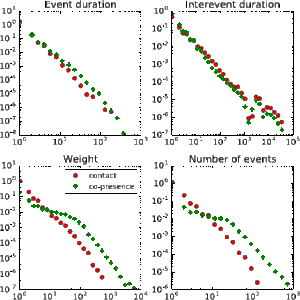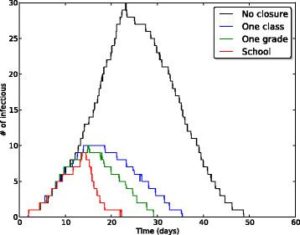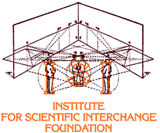PROJECT: Atlas of Human Interaction
[Under construction]
While never defined as an explicit project, the objectives it represents were a main motivator for setting up the SocioPatterns project to begin with, and several –if not all– deployments were (partly) conceived and executed with these objectives in mind.
Publications associated with this project:
- High Resolution Dynamical Mapping of Social Interactions With Active RFID.
Alain Barrat, Ciro Cattuto, Vittoria Colizza, Jean-Francois Pinton, Wouter Van den Broeck, and Alessandro Vespignani. Informal arXiv.org publication, Nov 2008.
  
@ARTICLE{2008arXiv0811.4170B,
author = {Barrat, Alain and Cattuto, Ciro and Colizza, Vittoria and Pinton, {Jean-François}
and {Van den Broeck}, Wouter and Vespignani, Alessandro},
title = {High Resolution Dynamical Mapping of Social Interactions With Active RFID},
journal = {ArXiv e-prints},
archivePrefix = {arXiv},
eprint = {0811.4170},
primaryClass = {cs.CY},
keywords = {Computer Science - Computers and Society, Computer Science
- Human-Computer Interaction, Physics - Physics and Society},
year = 2008,
month = nov,
adsurl = {http://adsabs.harvard.edu/abs/2008arXiv0811.4170B},
adsnote = {Provided by the SAO/NASA Astrophysics Data System},
keywords = {SocioPatterns}
}- What’s in a Crowd? Analysis of Face-to-Face Behavioral Networks.
Lorenzo Isella, Juliette Stehlé, Alain Barrat, Ciro Cattuto, Jean-François Pinton, and Wouter Van den Broeck. Journal of Theoretical Biology 271 (2011) 166-180.
 
@article{Isella:2011qo,
title = {What's in a Crowd? Analysis of Face-to-Face Behavioral Networks},
journal = {Journal of Theoretical Biology},
volume = 271,
number = 1,
pages = {166--180},
year = 2011,
issn = {0022-5193},
doi = {DOI: 10.1016/j.jtbi.2010.11.033},
url = {http://www.sciencedirect.com/science/article/B6WMD-51M60KS-2/2/cb31bee32b340b3044c724b88779a60e},
author = {Isella, Lorenzo and Stehlé, Juliette and Barrat, Alain and Cattuto, Ciro and
Pinton, {Jean-François} and {Van den Broeck}, Wouter},
keywords = {SocioPatterns}
}- Social Dynamics in Conferences: Analysis of Data from the Live Social Semantics Application.
Alain Barrat, Ciro Cattuto, Martin Szomszor, Wouter Van den Broeck, and Harith Alani. In: Proceedings of the 9th International Semantic Web Conference (ISWC'10), 2010.
  
@inproceedings{sdc_iswc10,
booktitle = {Proceedings of the 9th International Semantic Web Conference (ISWC '10)},
title = {Social Dynamics in Conferences: Analysis of Data from the
Live Social Semantics Application.},
author = {Barrat, Alain and Cattuto, Ciro and Szomszor, Martin and
{Van den Broeck}, Wouter and Alani, Harith},
year = {2010},
url = {http://iswc2010.semanticweb.org/accepted-papers/410},
keywords = {SocioPatterns, Live Social Semantics}
}- Dynamics of Person-to-Person Interactions from Distributed RFID Sensor Networks.
Ciro Cattuto, Wouter Van den Broeck, Alain Barrat, Vittoria Colizza, Jean-François Pinton, and Alessandro Vespignani. PLOS ONE 5(7): e11596. doi:10.1371/journal.pone.0011596, July 2010.
  
@article{10.1371/journal.pone.0011596,
author = {Cattuto, Ciro and {Van den Broeck}, Wouter and Barrat, Alain and
Colizza, Vittoria and Pinton, {Jean-François} and Vespignani, Alessandro},
journal = {PLOS ONE},
publisher = {Public Library of Science},
title = {Dynamics of Person-to-Person Interactions from Distributed RFID Sensor Networks},
year = {2010},
month = {07},
volume = {5},
url = {http://dx.doi.org/10.1371%2Fjournal.pone.0011596},
pages = {e11596},
number = {7},
doi = {10.1371/journal.pone.0011596},
keywords = {SocioPatterns}
}

|
 |
NEWS
Through a publication in EPJ Data Science, we have released several new data sets of different types. These datasets can be found on Zenodo.
On the one hand, we have released new temporally resolved data on face-to-face interactions collected in
- the SFHH scientific conference held in 2009, with more than 400 participants to the data collection, a data set that we have already used in several publications such as “Simulation of an SEIR infectious disease model on the dynamic contact network of conference attendees”
- an office building (InVS, French Health observatory) in 2015 (following a first data collection performed in 2013, published here). This data set contains also metadata, i.e., to which department each individual belongs.
In addition, we release data sets describing the temporally resolved co-location of individuals, where co-location of two individuals at time t means that the same exact set of readers have received signals from both individuals at time t. Data can be found on our website or on Zenodo.
Obviously, the co-location data corresponds to a coarser spatial resolution than the face-to-face data, and we have compared the corresponding data in terms of structure and when used in data-driven simulations of disease propagation models in our paper.

After so many measurements concerning humans in different contexts (which we will continue measuring), SocioPatterns has partnered with different institutions to measure proximity networks of animals, ranging from free-roaming dogs to sheep and cows. The goals of the studies range from the study of social networks of animals to the development of better models of disease transmission in animal groups.
In order to fight and mitigate emerging epidemics, non-pharmaceutical interventions can become necessary. Among these, school closure is typically regarded as a viable mitigation strategy: children indeed are known to play an important role in the propagation of infectious diseases, due to their high rate of contacts at school.
School closure is however a costly measure whose applicability remains uncertain and whose implementation should carefully be weighed on the basis of cost-benefit considerations.
In two successive studies published in BMC Infectious Diseases, we have used high resolution data on the contact patterns of children that we collected in a primary school,(i) to define and investigate alternative, less costly mitigation measures such as the targeted and reactive closure of single classes whenever symptomatic children are detected, at the scale of a single school and (ii) to evaluate the effectiveness of several such gradual reactive school closure strategies at the scale of entire municipalities.
Our results highlight a potential beneficial effect of reactive gradual school closure policies in mitigating influenza spread. Moreover, the suggested strategies are solely based on routinely collected and easily accessible data (such as student absenteeism irrespective) and thus they appear to be applicable in real world situations.
References:
Mitigation of infectious disease at school: targeted class closure vs school closure

SUPPORTED BY

|
![SocioPatterns [logo]](http://www.sociopatterns.org/wp-content/themes/sp2/images/header_logo.png)



